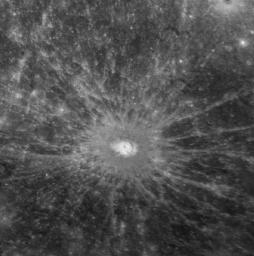
|
Debussy and its Hundreds of Miles of Rays
- Click the image above for a larger view
- Full-Res JPEG (1040 x 1048) (134.9 kB)
- Full-Res TIFF (1040 x 1048) (1.1 MB)
Caption:
This central-peak crater naturally draws attention because of its prominent rays, which extend hundreds of kilometers across the planet. Until receiving its official name of Debussy in March 2010, this crater had been known only as "feature A" in Earth-based radar images of Mercury. Debussy's extensive system of rays makes it a prominent, bright feature on Mercury's surface at both visible and radar wavelengths, and it was identified from early Earth-based radar observations long before the collection of spacecraft images of the crater. Appropriately, radar astronomer John K. Harmon was involved in proposing the name Debussy, as well as the name Hokusai for another spectacularly rayed crater discovered by radar. This crater's name honors Claude Debussy (1862-1918), a French composer. The first spacecraft images of Debussy were obtained during MESSENGER's second flyby of Mercury, revealing Debussy and its hundreds of miles of rays in unprecedented detail.
Date Acquired:
October 6, 2008
Instrument:
Narrow Angle Camera (NAC) of the Mercury Dual Imaging System (MDIS)
Resolution:
500 meters/pixel (0.31 miles/pixel)
Scale:
The diameter of Debussy is 85 kilometers (53 miles)
Projection:
This image is a portion of the
global Mercury
mosaic. It is shown in an
orthographic projection
.
Background Info:
These images are from MESSENGER, a NASA Discovery mission to conduct the first orbital study of the innermost planet, Mercury. For information regarding the use of images, see the MESSENGER image use policy .
Cataloging Keywords:
| Name | Value | Additional Values |
|---|---|---|
| Target | Mercury | |
| System | ||
| Target Type | Planet | |
| Mission | MESSENGER | |
| Instrument Host | MESSENGER | |
| Host Type | Orbiter | |
| Instrument | Mercury Dual Imaging System (MDIS) | |
| Detector | Narrow Angle Camera (NAC) | |
| Extra Keywords | Crater, Grayscale, Radar | |
| Acquisition Date | ||
| Release Date | 2010-07-06 | |
| Date in Caption | 2008-10-06 | |
| Image Credit | NASA/Johns Hopkins University Applied Physics Laboratory/Carnegie Institution of Washington | |
| Source | photojournal.jpl.nasa.gov/catalog/PIA13471 | |
| Identifier | PIA13471 | |
